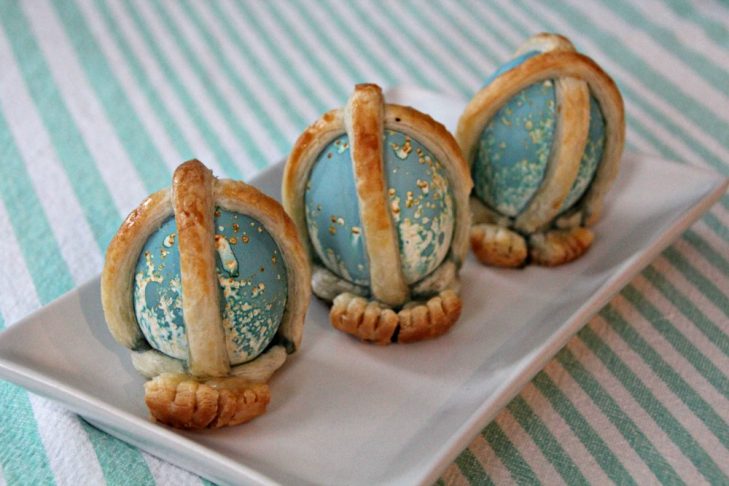Have you ever heard of foulares?
Neither had I, until I tried to find a traditional Purim recipe that wasn’t hamantaschen. And after extensive internet research and a trip to the Jewish cookbook section of the library, I’m still not totally clear. What I do know is that this hard-boiled egg-and-pastry hybrid originated in Balkan Jewish communities, and like many other Purim staples, it references Haman: the dough is often formed to represent Haman’s feet or ears, and shaped into bars “imprisoning” the egg (Haman). There are also alternate spellings and a Portuguese Easter bread with a similar name, facts that may have affected my relatively futile internet search.
Though cooking hard-boiled eggs in dough isn’t unheard of in Jewish cooking—there are many dishes that include baking eggs in challah dough, such as the Moroccan Jewish Ojos de Haman—this was the first I’d ever heard of this specific dish. I was intrigued and had to try it for myself. Here are five things I learned.
Dying the eggs is a good idea (but they won’t stay that color)
At first, I was disappointed to find that upon removing my foulares from the oven, the once-blue hard-boiled eggs now looked pocked and stained. But the more I looked at the Rorschach-test design on the shells, the more beauty I found in it. Just know that your perfect Robin’s egg blue ovoid won’t stay that color as the pastry bakes. Though next time, I might try making them with beet-pickled eggs.
Puff pastry makes a more convenient substitute for from-scratch dough
The few foulares recipes I found required you to use boreka or challah dough. I found that puff pastry made a fitting substitute that was not only easy to work with, but was also already in flat sheets perfect for cutting into ears, prison bars or feet (see the adorable feet in the photo above). Some foulares dough has cheese in it, which is easy enough to add to the puff pastry by grating some over the foulares before they go in the oven or as soon as they come out.
Egg wash gives the dough a golden-brown sheen—and makes it stick to the egg
Without an egg wash, the dough would have baked up pale. The golden-brown hue added necessary color, but it came at a cost: the excess egg wash that dripped onto the egg acted as an adhesive for the dough, which stuck to the eggshell pretty tightly. Conversely, I did try making some foulares with shelled hard-boiled eggs, but the dough didn’t stick at all to them, negating the most fun and challenging aspect of the recipe, which is shaping the dough around the egg.
There really is no easy way to eat them
And that’s part of the fun! Sure, the egg-washed dough stuck to the eggshell, but I was going to take the shell off before I ate it anyway. You basically end up with a pile of dough and a hard-cooked egg that you eat at your leisure.
They’re equal parts weird and wonderful
Baking dough wrapped around an already hard-cooked, shell-on egg? The concept contradicts all my culinary sensibilities, but sometimes you have to let history overrule them.



